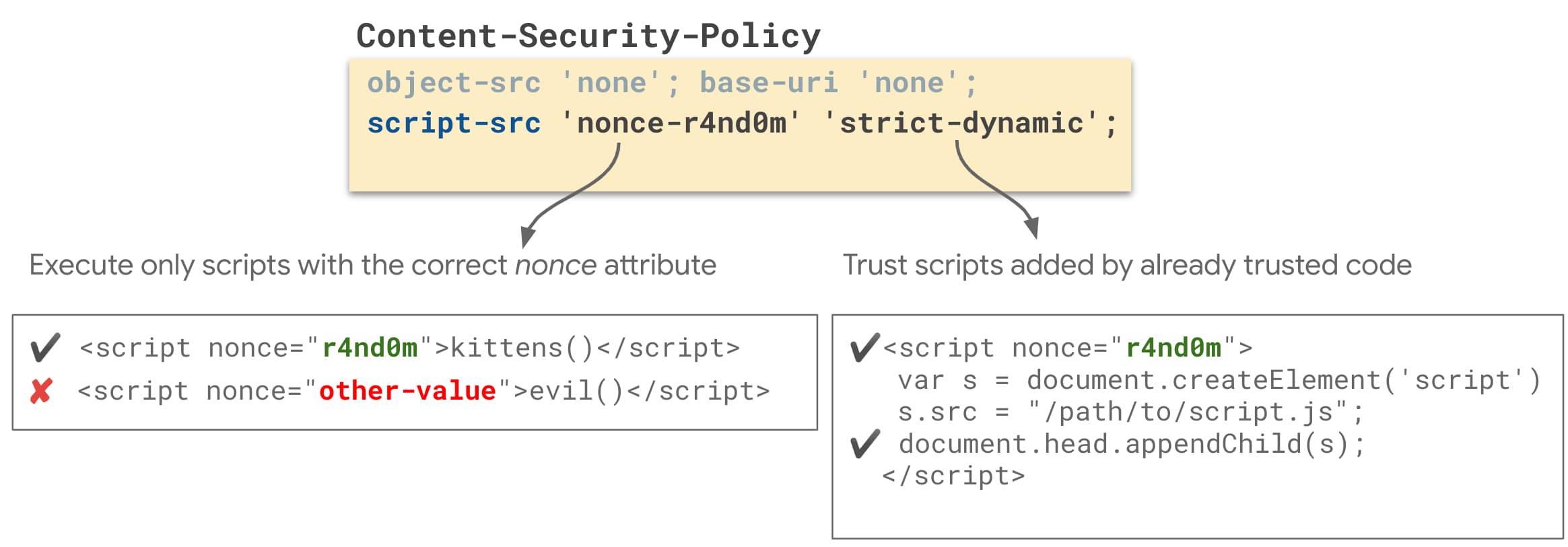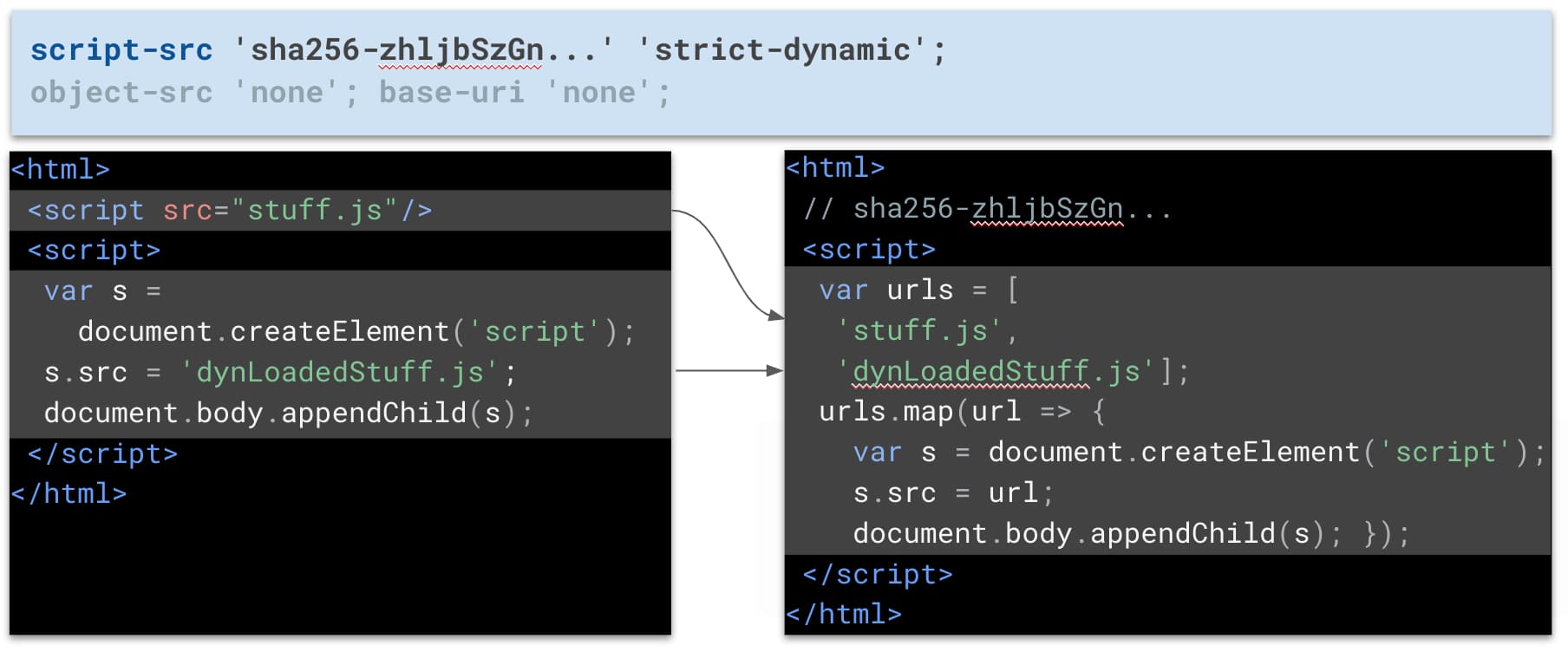Cross-site scripting (XSS), the ability to inject malicious scripts into a web app, has been one of the biggest web security vulnerabilities for over a decade.
Content Security Policy (CSP)
is an added layer of security that helps to mitigate XSS. To configure a CSP,
add the Content-Security-Policy HTTP header to a web page and set values that
control what resources the user agent can load for that page.
This page explains how to use a CSP based on nonces or hashes to mitigate XSS, instead of the commonly used host-allowlist-based CSPs that often leave the page exposed to XSS because they can be bypassed in most configurations.
Key term: A nonce is a random number used only once that you can use to mark a
<script> tag as trusted.
Key term: A hash function is a mathematical function that converts an input
value into a compressed numerical value called a hash. You can use a hash
(for example, SHA-256) to mark an inline
<script> tag as trusted.
A Content Security Policy based on nonces or hashes is often called a strict CSP. When an application uses a strict CSP, attackers who find HTML injection flaws generally can't use them to force the browser to execute malicious scripts in a vulnerable document. This is because strict CSP only allows hashed scripts or scripts with the correct nonce value generated on the server, so attackers can't execute the script without knowing the correct nonce for a given response.
Why should you use a strict CSP?
If your site already has a CSP that looks like script-src www.googleapis.com,
it's probably not effective against cross-site. This type of CSP is called an
allowlist CSP. They require a lot of customization and can be
bypassed by attackers.
Strict CSPs based on cryptographic nonces or hashes avoid these pitfalls.
Strict CSP structure
A basic strict Content Security Policy uses one of the following HTTP response headers:
Nonce-based strict CSP
Content-Security-Policy:
script-src 'nonce-{RANDOM}' 'strict-dynamic';
object-src 'none';
base-uri 'none';

Hash-based strict CSP
Content-Security-Policy:
script-src 'sha256-{HASHED_INLINE_SCRIPT}' 'strict-dynamic';
object-src 'none';
base-uri 'none';
The following properties make a CSP like this one "strict" and therefore secure:
- It uses nonces
'nonce-{RANDOM}'or hashes'sha256-{HASHED_INLINE_SCRIPT}'to indicate which<script>tags the site's developer trusts to execute in the user's browser. - It sets
'strict-dynamic'to reduce the effort of deploying a nonce- or hash-based CSP by automatically allowing the execution of scripts that a trusted script creates. This also unblocks the use of most third party JavaScript libraries and widgets. - It's not based on URL allowlists, so it doesn't suffer from common CSP bypasses.
- It blocks untrusted inline scripts like inline event handlers or
javascript:URIs. - It restricts
object-srcto disable dangerous plugins like Flash. - It restricts
base-urito block the injection of<base>tags. This prevents attackers from changing the locations of scripts loaded from relative URLs.
Adopt a strict CSP
To adopt a strict CSP, you need to:
- Decide whether your application should set a nonce- or hash-based CSP.
- Copy the CSP from the Strict CSP structure section and set it as a response header across your application.
- Refactor HTML templates and client-side code to remove patterns that are incompatible with CSP.
- Deploy your CSP.
You can use Lighthouse
(v7.3.0 and higher with flag --preset=experimental) Best Practices audit
throughout this process to check whether your site has a CSP, and whether it's
strict enough to be effective against XSS.

Step 1: Decide if you need a nonce- or hash-based CSP
Here's how the two types of strict CSP work:
Nonce-based CSP
With a nonce-based CSP, you generate a random number at runtime, include it in your CSP, and associate it with every script tag in your page. An attacker can't include or run a malicious script in your page, because they would need to guess the correct random number for that script. This only works if the number isn't guessable, and is newly generated at runtime for every response.
Use a nonce-based CSP for HTML pages rendered on the server. For these pages, you can create a new random number for every response.
Hash-based CSP
For a hash-based CSP, the hash of every inline script tag is added to the CSP. Each script has a different hash. An attacker can't include or run a malicious script in your page, because the hash of that script would need to be in your CSP for it to run.
Use a hash-based CSP for HTML pages served statically, or pages that need to be cached. For example, you can use a hash-based CSP for single-page web applications built with frameworks such as Angular, React or others, that are statically served without server-side rendering.
Step 2: Set a strict CSP and prepare your scripts
When setting a CSP, you have a few options:
- Report-only mode (
Content-Security-Policy-Report-Only) or enforcement mode (Content-Security-Policy). In report-only mode, the CSP won't block resources yet, so nothing on your site breaks, but you can see errors and get reports for anything that would have been blocked. Locally, when you're setting your CSP, this doesn't really matter, because both modes show you the errors in the browser console. If anything, enforcement mode can help you find resources your draft CSP blocks, because blocking a resource can make your page look broken. Report-only mode becomes most useful later in the process (see Step 5). - Header or HTML
<meta>tag. For local development, a<meta>tag can be more convenient for tweaking your CSP and quickly seeing how it affects your site. However:- Later on, when deploying your CSP in production, we recommend setting it as an HTTP header.
- If you want to set your CSP in report-only mode, you'll need to set it as a header, because CSP meta tags don't support report-only mode.
Set the following Content-Security-Policy HTTP response
header in your application:
Content-Security-Policy: script-src 'nonce-{RANDOM}' 'strict-dynamic'; object-src 'none'; base-uri 'none';
Generate a nonce for CSP
A nonce is a random number used only once per page load. A nonce-based CSP can only mitigate XSS if attackers can't guess the nonce value. A CSP nonce must be:
- A cryptographically strong random value (ideally 128+ bits in length)
- Newly generated for every response
- Base64 encoded
Here are some examples of how to add a CSP nonce in server-side frameworks:
- Django (python)
- Express (JavaScript):
const app = express(); app.get('/', function(request, response) { // Generate a new random nonce value for every response. const nonce = crypto.randomBytes(16).toString("base64"); // Set the strict nonce-based CSP response header const csp = `script-src 'nonce-${nonce}' 'strict-dynamic'; object-src 'none'; base-uri 'none';`; response.set("Content-Security-Policy", csp); // Every <script> tag in your application should set the `nonce` attribute to this value. response.render(template, { nonce: nonce }); });
Add a nonce attribute to <script> elements
With a nonce-based CSP, every <script> element must
have a nonce attribute that matches the random nonce
value specified in the CSP header. All scripts can have the same
nonce. The first step is to add these attributes to all scripts so the
CSP allows them.
Set the following Content-Security-Policy HTTP response
header in your application:
Content-Security-Policy: script-src 'sha256-{HASHED_INLINE_SCRIPT}' 'strict-dynamic'; object-src 'none'; base-uri 'none';
For multiple inline scripts, the syntax is as follows:
'sha256-{HASHED_INLINE_SCRIPT_1}' 'sha256-{HASHED_INLINE_SCRIPT_2}'.
Load sourced scripts dynamically
You can load third-party scripts dynamically using an inline script.

<script>
var scripts = [ 'https://example.org/foo.js', 'https://example.org/bar.js'];
scripts.forEach(function(scriptUrl) {
var s = document.createElement('script');
s.src = scriptUrl;
s.async = false; // to preserve execution order
document.head.appendChild(s);
});
</script>{HASHED_INLINE_SCRIPT}
placeholder. To reduce the amount of hashes, you can merge all inline
scripts into a single script. To see this in action, refer to this
example
and its code.
<script src="https://example.org/foo.js"></script> <script src="https://example.org/bar.js"></script>
integrity attribute which matches an allowed source.
Script loading considerations
The inline script example adds s.async = falseto ensure
that foo executes before bar, even if
bar loads first. In this snippet, s.async = false
doesn't block the parser while the scripts load, because the scripts are
added dynamically. The parser stops only while the scripts execute, as
it would for async scripts. However, with this snippet,
keep in mind:
-
One or both scripts might execute before the document has finished
downloading. If you want the document to be ready by the time the
scripts execute, wait for the
DOMContentLoadedevent before you append the scripts. If this causes a performance issue because the scripts don't start downloading early enough, use preload tags earlier on the page. -
defer = truedoesn't do anything. If you need that behaviour, run the script manually when it's needed.
Step 3: Refactor HTML templates and client-side code
Inline event handlers (such as onclick="…", onerror="…") and JavaScript URIs
(<a href="javascript:…">) can be used to run scripts. This means an
attacker who finds an XSS bug can inject this kind of HTML and execute malicious
JavaScript. A nonce- or hash-based CSP prohibits the use of this kind of markup.
If your site uses any of these patterns, you'll need to refactor them into safer
alternatives.
If you enabled CSP in the previous step, you'll be able to see CSP violations in the console every time CSP blocks an incompatible pattern.

In most cases, the fix is straightforward:
Refactor inline event handlers
<span id="things">A thing.</span>
<script nonce="${nonce}">
document.getElementById('things').addEventListener('click', doThings);
</script><span onclick="doThings();">A thing.</span>
Refactor javascript: URIs
<a id="foo">foo</a>
<script nonce="${nonce}">
document.getElementById('foo').addEventListener('click', linkClicked);
</script><a href="javascript:linkClicked()">foo</a>
Remove eval() from your JavaScript
If your application uses eval() to convert JSON string serializations into JS
objects, you should refactor such instances to JSON.parse(), which is also
faster.
If you can't remove all uses of eval(), you can still set a strict nonce-based
CSP, but you have to use the 'unsafe-eval' CSP keyword, which makes your
policy slightly less secure.
You can find these and more examples of such refactoring in this strict CSP codelab:
Step 4 (Optional): Add fallbacks to support old browser versions
If you need to support older browser versions:
- Using
strict-dynamicrequires addinghttps:as a fallback for earlier versions of Safari. When you do this:- All browsers that support
strict-dynamicignore thehttps:fallback, so this won't reduce the strength of the policy. - In old browsers, externally sourced scripts can load only if they come from
an HTTPS origin. This is less secure than a strict CSP, but it still
prevents some common XSS causes like injections of
javascript:URIs.
- All browsers that support
- To ensure compatibility with very old browser versions (4+ years), you can add
unsafe-inlineas a fallback. All recent browsers ignoreunsafe-inlineif a CSP nonce or hash is present.
Content-Security-Policy:
script-src 'nonce-{random}' 'strict-dynamic' https: 'unsafe-inline';
object-src 'none';
base-uri 'none';
Step 5: Deploy your CSP
After confirming that your CSP doesn't block any legitimate scripts in your local development environment, you can deploy your CSP to staging, then to your production environment:
- (Optional) Deploy your CSP in report-only mode using the
Content-Security-Policy-Report-Onlyheader. Report-only mode is handy to test a potentially breaking change like a new CSP in production before you start enforcing CSP restrictions. In report-only mode, your CSP doesn't affect your app's behavior, but the browser still generates console errors and violation reports when it encounters patterns incompatible with your CSP, so you can see what would have broken for your end users. For more information, see Reporting API. - When you're confident that your CSP won't break your site for your end-users,
deploy your CSP using the
Content-Security-Policyresponse header. We recommend setting your CSP using an HTTP header server-side because it's more secure than a<meta>tag. After you complete this step, your CSP starts protecting your app from XSS.
Limitations
A strict CSP generally provides a strong added layer of security that helps to
mitigate XSS. In most cases, CSP reduces the attack surface significantly, by
rejecting dangerous patterns like javascript: URIs. However, based on the type
of CSP you're using (nonces, hashes, with or without 'strict-dynamic'), there
are cases where CSP doesn't protect your app as well:
- If you nonce a script, but there's an injection directly into the body or the
srcparameter of that<script>element. - If there are injections into the locations of dynamically created scripts
(
document.createElement('script')), including into any library functions that createscriptDOM nodes based on the values of their arguments. This includes some common APIs such as jQuery's.html(), as well as.get()and.post()in jQuery < 3.0. - If there are template injections in old AngularJS applications. An attacker that can inject into an AngularJS template can use it to execute arbitrary JavaScript.
- If the policy contains
'unsafe-eval', injections intoeval(),setTimeout(), and a few other rarely used APIs.
Developers and security engineers should pay particular attention to such patterns during code reviews and security audits. You can find more details on these cases in Content Security Policy: A Successful Mess Between Hardening and Mitigation.

